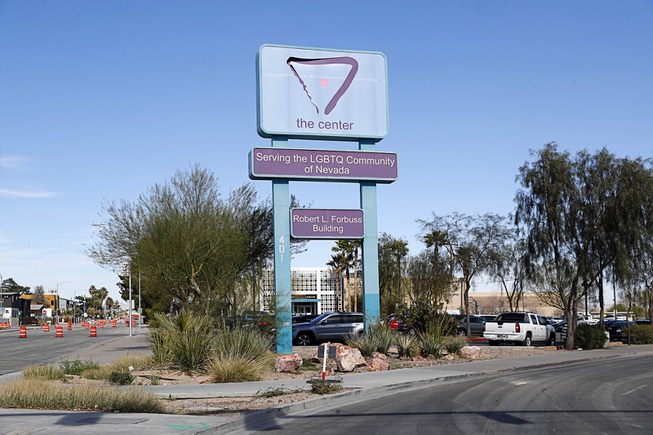
An exterior view of The Center, serving the LGBTQ community of Nevada, near downtown Las Vegas Thursday, Feb. 29, 2024.
Sunday, March 10, 2024 | 3 a.m.
Dr. Jerry Cade has spent much of his career trying to decrease stigma surrounding human immunodeficiency virus, better known as HIV.
Cade was the medical director for University Medical Center’s HIV Wellness program from 1985 to 2022 and is continuing his work in educating residents about HIV at The Center, a resource hub for the LGBTQ community in downtown.
The most recent data from the Nevada Department of Health and Human Services’ division of public and behavioral health shows an increase in HIV diagnoses in the past few years in the state, but Cade said the reason may not be bad.
The data showed Clark County recorded 488 diagnoses of HIV — about 91% of the state’s total — in 2022, the most recent year that data is available. It’s an increase from the 441 cases in 2021, 325 cases in 2020 and 448 in 2019.
“I learned from statistics class to be careful about making predictions from one small moment in history, so you always wonder if it’s a fluke or not, but we really are pushing for more testing,” Cade said. “I’m not so sure that we’re not seeing more HIV — that doesn’t mean that didn’t exist — but I think we might be finding more HIV, which ultimately will be a good thing because we put people on medications, (and) if they’re not detectable, they can’t transmit the virus.”
Still, the rise in cases was enough for Clark County to be flagged by the federal government’s Ending the HIV Epidemic Initiative, said Dr. Rosanne Sugay, medical epidemiologist at the Southern Nevada Health District (SNHD).
The initiative allows the federal Centers for Disease Control and Prevention to work with participating agencies to increase investment in “proven HIV prevention tools and newer innovative technologies and programs.” It provides funding to targeted counties, such as Clark, to boost effective HIV mitigation and care programs in communities hardest hit by HIV, according to the initiative’s website.
Importance of testing
The increase of cases has been felt everywhere, from patients seeking treatment and counseling services at The Center to HIV-positive residents asking for rental support through Golden Rainbow.
More HIV-positive people in their late teens and early 20s are showing up at the doorsteps of Golden Rainbow — a group that provides long-term and transitional housing, assistance and education to low-income individuals and families affected by HIV.
Gary Costa, executive director at Golden Rainbow, believes the region could be seeing more HIV diagnoses for several reasons, such as commercials sending “confusing” messaging around HIV medications that don’t acknowledge the dangers of the virus and a lack of STD testing throughout the COVID pandemic.
“All these other sexually transmitted diseases, like HIV, were not being pursued; we weren’t actively out there testing, sending out messages to continue to get tested and protect yourself and be treated for these things,” Costa said. “We fell behind for three years, so yes we’re gonna be seeing a lot of HIV for the next few years, we’re gonna be seeing a lot of gonorrhea, gonna see a lot of syphilis because it’s going to take awhile for us to come down off of that three-year gap.”
Costa says stable housing and regular access to medications help HIV-positive people stay healthy, which lengthens their life span and mitigates the impact of the virus.
Cade said The Center had seen an increase in the number of people getting tested. SNHD has been boosting its testing, offering home kits with which residents can send their sample to the Health District through mail.
Testing is important, Sugay explained, because identifying HIV-positive people means they can be put on treatment that would eventually make their viral load “undetectable.” Once someone with HIV has undetectable levels of the virus, they cannot transmit it to anyone, she said.
“The first key step to ending the HIV epidemic and improving our kind of care cascade for HIV is diagnosing people or identifying the people who are positive — I don’t think that’s a foreign concept after COVID and what we did,” Sugay said.
The Center has completed more than 10,000 HIV and STD/STI tests since 2013 as well as over 1,900 PrEP prescriptions — the pre-exposure prophylaxis that reduces a person’s chances of getting HIV through sex or injections from drug use.
The Center additionally offers an education class (HIV 101) that “provides an overview of essential facts” about the virus, transmission, prevention and services available to residents living with HIV or AIDS.
It also has a Living Well life-support group for people living with HIV/AIDS, a health education dinner to spread information on treatment options and safe sex kits.
“My goal is for everybody in Clark County to get tested so that we can do the appropriate follow-up action,” Cade said. “We have the tools to eliminate HIV, if we could just get the political will together to make it happen … Let’s get everybody tested; let’s get them on medicines; let’s get rid of this thing.”
